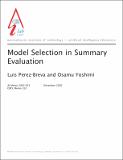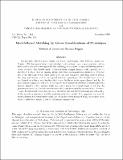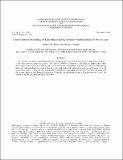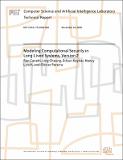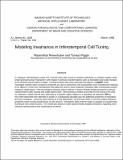Browsing Computer Science and Artificial Intelligence Lab (CSAIL) by Title
Now showing items 2047-2066 of 3804
-
Mobilized ad-hoc networks: A reinforcement learning approach
(2003-12-04)Research in mobile ad-hoc networks has focused on situations in which nodes have no control over their movements. We investigate an important but overlooked domain in which nodes do have control over their movements. ... -
A Model for Deliberation, Action, and Introspection
(1980-05-01)This thesis investigates the problem of controlling or directing the reasoning and actions of a computer program. The basic approach explored is to view reasoning as a species of action, so that a program might apply ... -
A Model for Interactive Computation: Applications to Speech Research
(1998-06)The speech research community has developed numerous toolkits to support ongoing research, e.g. Sapphire, Spire, ISP, ESPS/Waves+, HTK, CSLU Toolkit, LNKNet. While these toolkits contain extensive and useful functionality, ... -
A Model for Rivalry Between Cognitive Contours
(1990-06-01)The interactions between illusory and real contours have been inves- tigated under monocular, binocular and dichoptic conditions. Results show that under all three presentation conditions, periodic alternations, ... -
A Model for the Spatio-Temporal Organization of X- and Y-Type Ganglion Cells in the Primate Retina
(1980-04-01)A model is proposed for the spatial and temporal characteristics of X- and Y-type responses of ganglion cells in the primate retina. The model is related to a theory of directional selectivity proposed by Marr & Ullman ... -
A Model for Window Based Flow Control Packet-Switched Networks
(1998-03)Recently, networks have increased rapidly both in scale and speed. Problems related to the control and management are of increasing interest. However, there is no satisfactory tool to study the behavior of such networks. ... -
Model Selection for Solving Kinematics Problems
(1990-09-01)There has been much interest in the area of model-based reasoning within the Artificial Intelligence community, particularly in its application to diagnosis and troubleshooting. The core issue in this thesis, simply ... -
Model Selection in Summary Evaluation
(2002-12-01)A difficulty in the design of automated text summarization algorithms is in the objective evaluation. Viewing summarization as a tradeoff between length and information content, we introduce a technique based on ... -
Model-Based Matching by Linear Combinations of Prototypes
(1996-12-01)We describe a method for modeling object classes (such as faces) using 2D example images and an algorithm for matching a model to a novel image. The object class models are "learned'' from example images that we call ... -
Model-Based Matching of Line Drawings by Linear Combinations of Prototypes
(1996-01-18)We describe a technique for finding pixelwise correspondences between two images by using models of objects of the same class to guide the search. The object models are 'learned' from example images (also called ... -
Model-Based Reasoning: Troubleshooting
(1988-07-01)To determine why something has stopped working, it is useful to know how it was supposed to work in the first place. That simple observation underlies some of the considerable interest generated in recent years on the topic ... -
Model-Based Recognition and Localization from Sparse Range or Tactile Data
(1983-08-01)This paper discusses how local measurements of three-dimensional positions and surface normals (recorded by a set of tactile sensors, or by three-dimensional range sensors), may be used to identify and locate objects, ... -
Model-Based Robot Learning
(1988-04-01)Models play an important role in learning from practice. Models of a controlled system can be used as learning operators to refine commands on the basis of performance errors. The examples used to demonstrate this ... -
Model-Based Troubleshooting of Digital Systems
(1988-08-01)This thesis describes a methodology, a representation, and an implemented program for troubleshooting digital circuit boards at roughly the level of expertise one might expect in a human novice. Existing methods for ... -
A Model-debugging System
(1974) -
Model-Driven Geometry Theorem Prover
(1975-05-01)This paper describes a new Geometry Theorem Prover, which was implemented to illuminate some issues related to the use of models in theorem provin. The paper is divided into three parts: Part 1 describes G.T.P. and ... -
Modeling and Verification of Randomized Distributed Real -Time Systems
(1996-06)Randomization is an excellent tool for the design of distributed algorithms, sometimes yielding efficient solutions to problems that are inherently complex, or even unsolvable, in the setting of deterministic algorithms. ... -
Modeling Computational Security in Long-Lived Systems, Version 2
(2008-11-22)For many cryptographic protocols, security relies on the assumption that adversarial entities have limited computational power. This type of security degrades progressively over the lifetime of a protocol. However, some ... -
Modeling Invariances in Inferotemporal Cell Tuning
(1998-03-01)In macaque inferotemporal cortex (IT), neurons have been found to respond selectively to complex shapes while showing broad tuning ("invariance") with respect to stimulus transformations such as translation and scale changes ...







